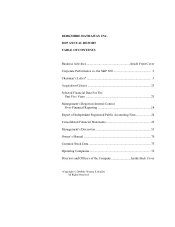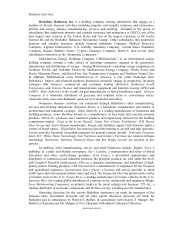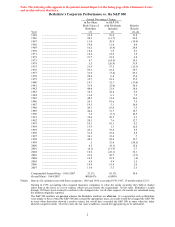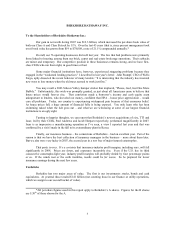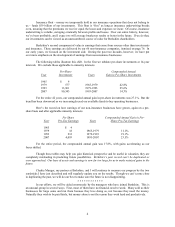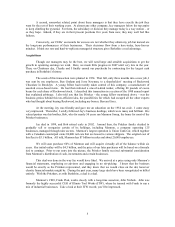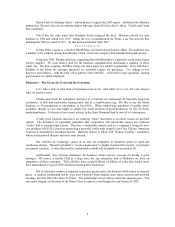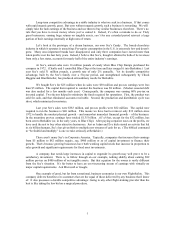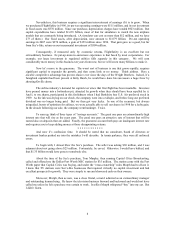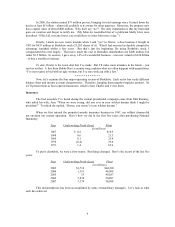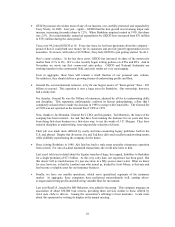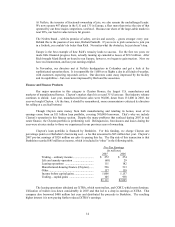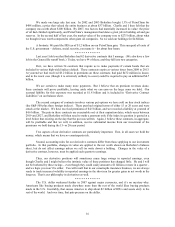Berkshire Hathaway 2007 Annual Report Download - page 7
Download and view the complete annual report
Please find page 7 of the 2007 Berkshire Hathaway annual report below. You can navigate through the pages in the report by either clicking on the pages listed below, or by using the keyword search tool below to find specific information within the annual report. Byron Trott of Goldman Sachs – whose praises I sang in the 2003 report – facilitated the Marmon
transaction. Byron is the rare investment banker who puts himself in his client’ s shoes. Charlie and I trust
him completely.
You’ ll like the code name that Goldman Sachs assigned the deal. Marmon entered the auto
business in 1902 and exited it in 1933. Along the way it manufactured the Wasp, a car that won the first
Indianapolis 500 race, held in 1911. So this deal was labeled “Indy 500.”
* * * * * * * * * * * *
In May 2006, I spoke at a lunch at Ben Bridge, our Seattle-based jewelry chain. The audience was
a number of its vendors, among them Dennis Ulrich, owner of a company that manufactured gold jewelry.
In January 2007, Dennis called me, suggesting that with Berkshire’ s support he could build a large
jewelry supplier. We soon made a deal for his business, simultaneously purchasing a supplier of about
equal size. The new company, Richline Group, has since made two smaller acquisitions. Even with those,
Richline is far below the earnings threshold we normally require for purchases. I’ m willing to bet,
however, that Dennis – with the help of his partner, Dave Meleski – will build a large operation, earning
good returns on capital employed.
Businesses – The Great, the Good and the Gruesome
Let’ s take a look at what kind of businesses turn us on. And while we’ re at it, let’ s also discuss
what we wish to avoid.
Charlie and I look for companies that have a) a business we understand; b) favorable long-term
economics; c) able and trustworthy management; and d) a sensible price tag. We like to buy the whole
business or, if management is our partner, at least 80%. When control-type purchases of quality aren’ t
available, though, we are also happy to simply buy small portions of great businesses by way of stock-
market purchases. It’ s better to have a part interest in the Hope Diamond than to own all of a rhinestone.
A truly great business must have an enduring “moat” that protects excellent returns on invested
capital. The dynamics of capitalism guarantee that competitors will repeatedly assault any business
“castle” that is earning high returns. Therefore a formidable barrier such as a company’ s being the low-
cost producer (GEICO, Costco) or possessing a powerful world-wide brand (Coca-Cola, Gillette, American
Express) is essential for sustained success. Business history is filled with “Roman Candles,” companies
whose moats proved illusory and were soon crossed.
Our criterion of “enduring” causes us to rule out companies in industries prone to rapid and
continuous change. Though capitalism’ s “creative destruction” is highly beneficial for society, it precludes
investment certainty. A moat that must be continuously rebuilt will eventually be no moat at all.
Additionally, this criterion eliminates the business whose success depends on having a great
manager. Of course, a terrific CEO is a huge asset for any enterprise, and at Berkshire we have an
abundance of these managers. Their abilities have created billions of dollars of value that would never
have materialized if typical CEOs had been running their businesses.
But if a business requires a superstar to produce great results, the business itself cannot be deemed
great. A medical partnership led by your area’ s premier brain surgeon may enjoy outsized and growing
earnings, but that tells little about its future. The partnership’ s moat will go when the surgeon goes. You
can count, though, on the moat of the Mayo Clinic to endure, even though you can’ t name its CEO.
6

